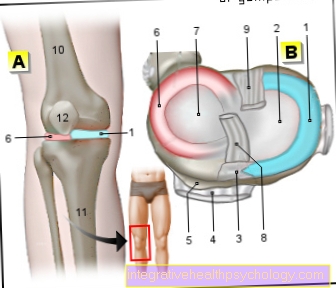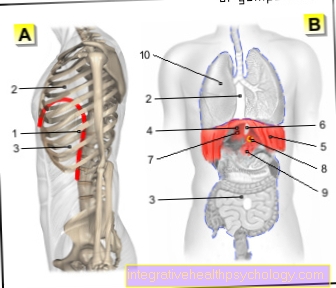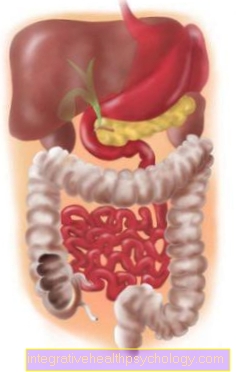Viral rash
definition
A viral rash is a skin rash caused by infection with a viral pathogen. This appears reddened, usually does not itch and shows a uniform appearance. A distinction is made between the infectious and the parainfectious virus eruption, depending on whether one or more pathogens are involved in the development. Concomitant symptoms are often swollen lymph nodes and reddened mucous membranes. The rash occurs more often in childhood.

Cause of a viral rash
A virus rash occurs particularly in small children. Therefore, the causative viruses are predominantly viral pathogens relevant in childhood. The pathogens include e.g. the causative agents of measles, mumps, rubella, rubella (Parvovirus B19), hand, foot and mouth disease (Coxsacki virus A16) and rotaviruses. From the group of herpes viruses are the pathogens of chickenpox (varicella-zoster virus), three-day fever (human herpes virus 6 and 7, HHV 6 and 7) and herpes simplex viruses, which among others Cause herpes on the lip, to be named as the cause of a virus eruption.
Furthermore, Epstein-Barr viruses (Pfeiffer's glandular fever) and hepatitis B viruses (Gianotti-Crosti syndrome) can trigger the development of a rash. A rarer cause is the dengue virus, which can cause so-called dengue fever, especially in people returning from Central Africa and South America. If a virus-related rash occurs, a fresh HIV infection should always be considered and an appropriate examination and diagnosis should be carried out.
You might also be interested in: First symptoms of HIV infection such as Herpes in babies - is that dangerous?
Concomitant symptoms
The symptoms of various viral eruptions can be varied. What they have in common, however, is that they are almost always accompanied by a fever and not itchy.
Early symptoms of a cold and a general feeling of illness can also point the way. There is also accompanying swelling of the lymph nodes. A viral rash often occurs initially on the head and then spreads to the face and neck, sometimes over the entire body. This is what differentiates the viral rash from a rash caused by certain drugs. This usually begins on the trunk of the body (stomach, chest, back), then spreads over the whole body and often itches the person affected. A typical trigger is e.g. Penicillin. An exception, however, is the rash in the context of the viral Gianotti-Crosti syndrome, in which the rash appears on the legs and buttocks in addition to the head.
More on this subject: Rash on the face such as Medication rash
therapy
Treatment of the viral rash depends on the cause. Teething troubles are usually treated symptomatically until the symptoms have subsided. This can be done with antipyretic or cough suppressant medication. In the case of infections with varicella zoster viruses or herpes simplex viruses, the antiviral acyclovir can be used. During pregnancy and breastfeeding, however, acyclovir can only be used to a limited extent and should therefore be discussed in detail with the attending physician.
In addition, there are a few general measures you can take yourself to treat rashes so that the rash disappears quickly and heals without consequences. You should not scratch in the area of the exanthema, as further pathogens can penetrate the body through injured areas of the skin. In addition, hot baths and showers should be avoided as these irritate the skin. In terms of personal hygiene, it is also advisable to use a pH-neutral shower gel and not harsh, perfumed soaps or lotions.
diagnosis
Based on the clinical picture and the medical history, the doctor can already get clues about the cause of the rash. With some viral pathogens, the rash occurs in typical body locations or is typical of a certain season. The causative agent of three-day fever causes e.g. typically a rash on the neck and trunk and often occurs in spring or autumn. The general condition of the patient can also point the way; measles disease is associated with a serious feeling of illness. If the clinical examination does not allow a clear diagnosis, this can be supplemented by blood tests and smears with a subsequent microscopic examination of the tissue.
Viral rash in toddlers and babies
The reason why viral eruptions occur more often in infancy and toddler age is that this age group is more susceptible to viral infections. Newborns have a certain immunity from their mother for a few weeks to months after birth. This protection can be increased by breastfeeding the baby. If this protection is lost at some point, however, the children are not protected against viral pathogens to the same extent as adults with a mature immune system, since the body's own immunity has to develop over time. Vaccinations against viral pathogens such as the varicella zoster virus (pathogen causing chickenpox) are only given at the age of 12 months, which is why this disease can occur more frequently up to this point in time.
More information can be found here: Rash in the baby- what is the disease? such as Rash in children
Duration of healing
The rash starts a few hours to days after infection. The duration of the rash can also be very variable and ranges from a few hours for three-day fever to a week for rubella. As long as the rash is still present, it is assumed that the infection has not yet completely subsided. After the viral disease has successfully healed, e.g. lifelong immunity in measles, so a recurrence of the virus rash caused by these pathogens is no longer possible.
Risk of contagion
A virus eruption in itself is not contagious, but the disease on which it is based is. However, the time of infectivity is by no means always associated with the first appearance of the viral rash. Measles and rubella are contagious as early as 5-7 days before the visible rash appears; with rubella, for example, the risk of infection ends when the virus rash occurs. Therefore, in the case of such diseases, especially in small children, you should be careful to prevent close contact with other infants or small children, but also adults, in order to prevent infection.





























